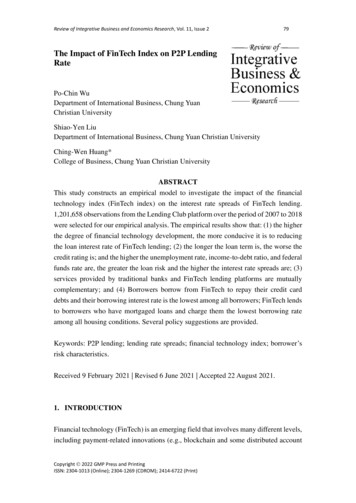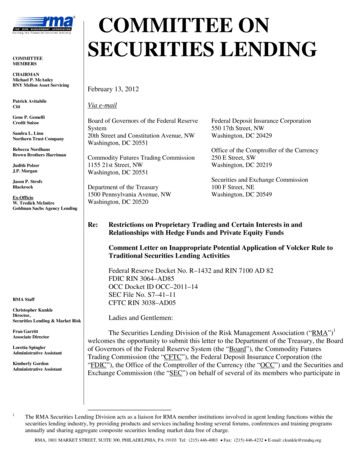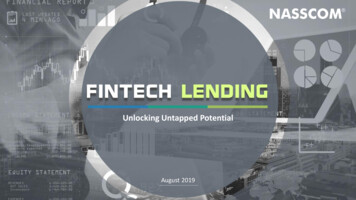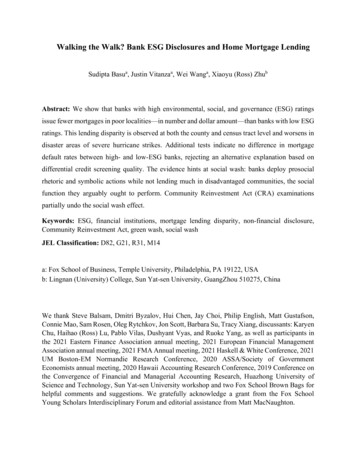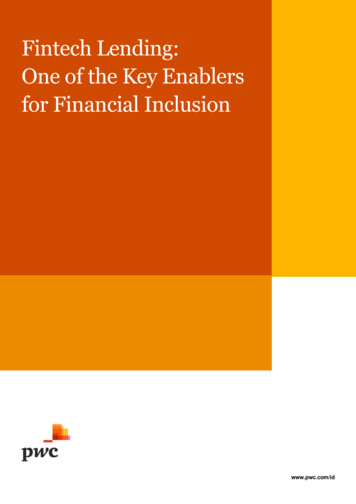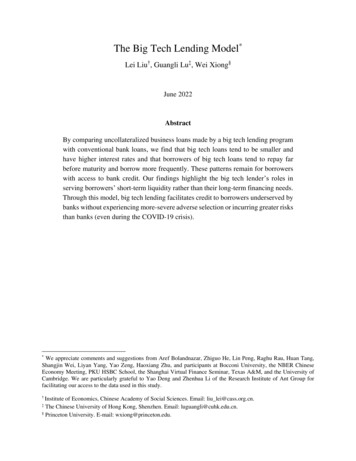
Transcription
The Big Tech Lending Model*Lei Liu†, Guangli Lu‡, Wei Xiong§June 2022AbstractBy comparing uncollateralized business loans made by a big tech lending programwith conventional bank loans, we find that big tech loans tend to be smaller andhave higher interest rates and that borrowers of big tech loans tend to repay farbefore maturity and borrow more frequently. These patterns remain for borrowerswith access to bank credit. Our findings highlight the big tech lender’s roles inserving borrowers’ short-term liquidity rather than their long-term financing needs.Through this model, big tech lending facilitates credit to borrowers underserved bybanks without experiencing more-severe adverse selection or incurring greater risksthan banks (even during the COVID-19 crisis).*We appreciate comments and suggestions from Aref Bolandnazar, Zhiguo He, Lin Peng, Raghu Rau, Huan Tang,Shangjin Wei, Liyan Yang, Yao Zeng, Haoxiang Zhu, and participants at Bocconi University, the NBER ChineseEconomy Meeting, PKU HSBC School, the Shanghai Virtual Finance Seminar, Texas A&M, and the University ofCambridge. We are particularly grateful to Yao Deng and Zhenhua Li of the Research Institute of Ant Group forfacilitating our access to the data used in this study.†Institute of Economics, Chinese Academy of Social Sciences. Email: liu lei@cass.org.cn.The Chinese University of Hong Kong, Shenzhen. Email: luguangli@cuhk.edu.cn.§Princeton University. E-mail: wxiong@princeton.edu.‡
Big tech companies across the world have started to offer lending services in recent years,either directly or in partnership with financial institutions. For example, in China, Alibaba, Baidu,and Tencent all offer credit services through their subsidiaries, while in the United States, Apple,Amazon, and Google also offer credit services. Aided by advantages in information, distribution,technology, and monitoring embedded in these big tech companies’ ecosystems, the global volumeof big tech lending grew rapidly, from 10.6 billion in 2013 to 572 billion in 2019, more thantwice the volume of fintech lending, which mainly consists of decentralized online platforms thatmatch lenders with borrowers and use unconventional data to assist lenders with credit assessments(Cornelli, Frost, Gambacorta, Rau, Wardrop, and Ziegler (2020)). The rapid expansion of big techlending has raised many questions about its lending model and its potential disruptions to thebanking industry.While prior studies highlight the capacity of big tech lenders to provide credit and assist thebusiness development of borrowers underserved or unserved by traditional banks (LuohanAcademy Report (2019), Frost, Gambacorta, Huang, Shin, and Zbinden (2019), Cornelli et al.(2020), Huang, Zhang, Li, Qiu, Sun, Wang, and Berger (2020), Ghosh, Vallee, and Zeng (2021),Ouyang (2021), Gambacorta, Huang, Li, Qiu, and Chen (2022), Chen, Huang, Lin, and Sheng(2021)), several key questions remain. First, is big tech lending riskier than traditional bank lending?Is big tech lending robust to severe economic shocks that may create structural breaks to the riskassessment models used by big tech lenders? The recent evidence of fintech lending exacerbatingborrower risk and drying up during the COVID-19 crisis makes these concerns particularlyrelevant to big tech lending.1 Second, in order to systematically understand the risk involved in bigtech lending, it is necessary to understand how big tech lenders structure loans to help screenborrowers who are unable to qualify for bank credit and what these borrowers use big tech loansfor.We aim to address these issues by comparing big tech business loans made by the syndicationof MyBank, a pioneer big tech lender to small and medium enterprises (SMEs) in China, with alarge retail bank, which we refer to hereafter as Bank X for security reasons. China has the world’smost active big tech lending—with a loan volume of 516 billion in 2019—which is about 90%1Ben-David, Johnson and Stulz (2021) find that during the COVID-19 pandemic in March 2020, fintech lending tosmall businesses in the United States collapsed due to the drying up of loan supply as fintech lenders becamefinancially constrained and lost their ability to fund more loans. Bao and Huang (2021) show that in China, fintechlenders expanded credit to new and financially constrained borrowers after the start of the pandemic, but thedelinquency rate of fintech loans tripled, even though there was no significant change in the delinquency of bank loans.1
of the global volume. MyBank is a subsidiary of Ant Group, whose major shareholder is AlibabaGroup (“Alibaba” hereafter). Embedded in Alibaba’s ecosystem, MyBank’s borrowers are mostlySMEs and the self-employed. Founded only in 2015, it had cumulatively lent to 35.07 millionSMEs by 2020. MyBank’s lending is primarily funded by syndication with traditional banks. BankX is one of MyBank’s top syndication partners, and its syndicated loans with MyBank arerepresentative of MyBank’s syndicated loan portfolio. In this syndication program, both bankscontribute funding to each loan.2 MyBank is responsible for acquiring borrowers, processing loanapplications, and managing the loans after origination; it also recommends interest rates and creditlimits to Bank X. The latter decides whether to accept a loan. Bank X evaluates the recommendedinterest rates and credit limits and normally follows the recommendations of MyBank.Our data come from Bank X and cover loans from three business lending programs: big techloans made through the syndication program of MyBank and Bank X, and regular and online loansfrom Bank X’s two conventional lending programs, which are both independently managed byBank X. We obtain a 10% random sample of borrowers in each of the three lending programs andall loans made to these borrowers from August 2019 to December 2020.The big tech lending program serves borrowers with substantially more limited access to creditfrom other sources relative to Bank X’s regular and online lending programs. The big tech loansin our sample are also sharply different from Bank X’s regular loans and online loans in manyaspects. More than 98% of the big tech loans are uncollateralized, which is substantially higherthan the fraction among Bank X’s conventional loans, and thus motivates us to focus our analysison uncollateralized loans. Uncollateralized big tech loans have an average annualized interest rateof 14.6%, with a range from 4.4% to 21.6%. In contrast, Bank X’s uncollateralized regular loanshave an average interest rate of 8.5%, with a range from 4.2% to 16.2%, and Bank X’s online loanshave an average interest rate of 8.6%, with a range from 4.2% to 18.0%. The uncollateralized creditlimit offered by the big tech lending program is less than half of that offered by Bank X’s regularand online lending programs.To examine whether the big tech loans are riskier than Bank X’s regular and online loans, wemeasure repayment risk by the likelihood of a loan payment being overdue by at least 30 days.The overall delinquency rate is 2.6% for the big tech loans, which is higher than the rate of 1.6%for the regular loans and 1.1% for the online loans. Interestingly, nearly half of the big tech loans2According to the Chinese banking regulations, each institution in an online syndication loan must contribute at least30% of the funding.2
in our sample are made to first-time borrowers of the big tech lending program. Among the loansmade to borrowers that have previously paid off at least one loan from the same lending program,the delinquency rate of the big tech loans is only 1.2%, very similar to that of Bank X’s regularand online loans. Our regression analysis also confirms that there is no difference in repaymentrisk after controlling for borrower and loan characteristics. Our analysis of the delinquency rate ofloans originated before and after the start of the COVID-19 pandemic in China in February 2020further shows that the risk in the big tech loans remained stable, even slightly reduced, relative toBank X’s conventional loans after the onset of the COVID-19 pandemic. These findings show therobustness of the big tech lender’s risk assessment model to a severe economic shock and are insharp contrast to the aforementioned evidence of fintech loans exacerbating borrower default riskand becoming more fragile after the COVID-19 pandemic started.It is surprising that the big tech loans do not display greater risk, despite the borrowers’ lowercredit quality and higher interest rates. To understand this important finding, we adopt thecorrelation test proposed by Chiappori and Salanié (2000) to examine the presence of adverseselection in each of these lending programs. Each program allows an authorized borrower to takea loan within a credit limit at a specified interest rate. This setting permits us to test whetherborrowers who choose to use up their credit limits are more likely to become delinquent later aftercontrolling for all public observables. A positive correlation indicates that the borrower has privateinformation about its greater repayment risk later. Interestingly, even though this test showsevidence of adverse selection among Bank X’s regular loans, we find advantageous selection inthe big tech loans: borrowers who choose to use up their credit limits in the big tech lendingprogram are less likely to become delinquent later. Such advantageous selection validates thecapacity of the big tech lender to screen or monitor borrowers, in contrast to the finding of Chavaet al. (2021) that fintech lenders in the United States face more-severe adverse selection than banks.Our analysis of repayment speed uncovers even sharper findings about what the borrowersmight have used the big tech loans for. Even though the big tech loans have short maturities ofeither 6 or 12 months, similar to Banks X’s regular and online loans, the big tech loans tend to berepaid far before the maturity date and substantially earlier than the other types of loans. Theaverage repayment time is only 46% of the loan maturity for the big tech loans, while it is 74%and 77% for Bank X’s online and regular loans, respectively. Interestingly, the 25th percentile ofthe ratio of repayment time to loan maturity is only 4% for the big tech loans, sharply lower thanthe 61% for the regular loans and 48% for the online loans. This sharp difference is robust in3
regression analysis after controlling for loan and borrower characteristics. The fast repaymentshows that borrowers are likely to use the big tech loans to meet short-term liquidity needs ratherthan as long-term financing. As fast repayment reduces the big tech lender’s risk exposure to theborrowers, it helps explain the absence of greater repayment risk despite the borrowers’ lowercredit quality.To the extent that the borrowers lack access to credit services, they are likely to face a varietyof financing needs, not just short-term liquidity needs. If so, how does the big tech lenderdiscourage or prevent borrowers from using the loans to engage in long-term risky activities? Thelender has some capacity to partially monitor in its ecosystem whether a borrower’s use of theloans is consistent with the stated purposes. Furthermore, as the interest cost of a loan increaseswith the loan duration, the high interest rates of the big tech loans may also provide a mechanismto screen borrowers with short-term liquidity needs. That is, those who expect to repay quickly aremore willing to accept the high interest rates of the big tech loans and more likely to use up thecredit limit. This mechanism thus facilitates advantageous selection, leading to the aforementionednegative correlation between the initial use up of the credit limit and the later loan delinquency.Consistent with the high interest rates as a screening mechanism, we find that the big tech loans’interest rates are inelastic to, while the credit limits are elastic to, variations in borrowers’repayment risk.It is challenging to isolate the effects of demand-side and supply-side factors in driving thesharp patterns in the big tech loans’ substantially higher interest rates, lower credit limits, andfaster repayment. We address this challenge by examining a small set of big tech borrowers withaccess to Bank X’s regular or online loans. We find that big tech loans taken by these overlappedborrowers have quantitatively similar interest rates, credit limits, and repayment speeds as the bigtech loans in the main sample. Moreover, the interest rates are higher, the credit limits are lower,and the borrowers’ repayment speeds are faster relative to the conventional loans that theseoverlapped borrowers obtain from Bank X’s regular or online lending programs. These patternsremain even after we include borrower fixed effects (a full control for demand-side factors),confirming that the differences are mainly driven by heterogeneity in the lending programs.As these overlapped borrowers have better credit quality and outside options than other bigtech borrowers, one would expect them to get better terms. It is surprising that the big tech lender4
offers them similar interest rates and credit limits as other borrowers in the main sample, andconsequently, the overlapped borrowers also use the big tech loans to meet their short-termliquidity needs. In other words, the big tech lender does not offer more-competitive interest ratesto compete for the overlapped borrowers’ credit needs beyond their short-term liquidity needs.Our findings motivate a nuanced view of the restrained advantages of big tech lending: the bigtech lender may have unique advantages in providing credit services to a set of borrowersunderserved or unserved by traditional banks, but such credit services target the borrowers’ shortterm liquidity needs rather than long-term financing needs, inside the big tech lender’s ecosystem.Such big tech lending thus resembles leasing and financing that large manufacturing firms provideto downstream firms for purchasing their own products (e.g., Murfin and Pratt (2019)) and lendingby homebuilders’ finance arms to finance buyers’ home purchases (e.g., Stroebel (2016)), eventhough the scale of credit services covered by big tech lenders can be substantially wider than thatby manufacturing firms and homebuilders. This big tech lending model—by design—does notdirectly compete with traditional banks for the full spectrum of credit services, in contrast to acompelling view made by De la Mano and Padilla (2018) and Vives (2019) of big tech lendersusing their advantages in data and technology to eventually monopolize the origination anddistribution of loans to consumers and small and medium enterprises.Finally, it should be clear that our analysis covers only the current state of one big tech lendingprogram in China and offers no direct implications for how big tech lenders in other countries andin the future may compete with banks. The future landscape of the banking industry depends onnot only capital and risk regulations imposed on these institutions but also on regulations of datasharing among banks, fintech lenders, and big tech lenders, as explored by the theoretical modelsof He, Huang, and Zhou (2021) and Parlour, Rajan, and Zhu (2021).The Related LiteratureThere have been extensive studies of fintech lending, as recently reviewed by Berg, Fuster,and Puri (2021) and Allen, Gu, and Jagtiani (2021). This literature has accumulated importantunderstandings about fintech lending. First, unconventional data, such as digital footprints, can behighly useful for credit risk assessment, especially for borrowers with low credit scores and short5
credit histories. 3 Yet, fintech lenders may not have an information advantage compared totraditional banks that use soft information in lending.4 Second, fintech lending mainly substitutesfor bank lending, especially when banks are constrained, rather than targeting borrowers withoutaccess to regular bank credit. 5 Third, although technology may not necessarily allow fintechlenders to better screen borrowers excluded by banks, technology facilitates fast and convenientapplication processes, which is a key advantage of fintech lenders. Furthermore, as fintech lendersdo not take deposits, they face less stringent regulatory requirements, which is another keyadvantage fintech lenders have relative to banks.6 Fourth, fintech lending may worsen, rather thanimprove, the borrowers’ financial health. 7 Fifth, fintech lending may not be robust to severeeconomic shocks such as the COVID-19 pandemic, as mentioned in Footnote 1.By using data from an e-commerce company in Germany, Berg, Burg, Gombović and Puri (2020) show that digitalfootprints that users leave online when accessing or registering on a website complement the information content ofcredit scores and can thus improve the prediction of consumer default. By analyzing data from a major fintech platformthat provides consumer loans, Upstart Network, Di Maggio, Ratnadiwakara and Carmichael (2021) show thatalternative data can be particularly useful in screening “invisible primes”—borrowers with low credit scores and shortcredit histories.4Chava, Ganduri, Paradkar and Zhang (2021) show that U.S. borrowers in marketplace lending platforms have higherdefault rates in the long run relative to observably similar applicants of bank loans, suggesting that marketplace lendersface more-severe adverse selection relative to traditional banks.5Tang (2019) shows that peer-to-peer (P2P) lending in the United States is a substitute for bank lending in that itserves inframarginal bank borrowers after a negative shock to bank credit supply induced by regulations. De Roure,Pelizzon and Thakor (2021) provide both theoretical and empirical analysis to reinforce the notion that P2P lendersare bottom-fishing, that is, they compete with banks for the lower spectrum of borrowers with access to bank credit.Di Maggio and Yao (2021) find that the quality of fintech borrowers improves over time, and on average, fintechborrowers have higher incomes, better education, higher credit scores, and more access to credit than bank borrowers.By comparing borrowers of consumer credit from three fintech firms with credit card borrowers of a leading stateowned bank in China, Bao and Huang (2021) find that fintech borrowers have more car loans, more mortgages, andmore credit access than the bank borrowers, although they have less income and education and are less likely to beemployed than the latter. Gopal and Schnabl (2021) document that fintech lenders increased lending to smallbusinesses after the 2008 financial crisis to substitute for the reduction in lending by banks. Beaumont, Tang andVansteenberghe (2021) use French data to show a nuanced complementarity for fintech lending and bank lending:small and medium-sized enterprises may use uncollateralized fintech loans to acquire tangible assets that they canthen pledge to obtain bank loans.6Fuster, Plosser, Schnabl and Vickery (2019) show that fintech lenders in the United States mortgage market processmortgage applications 20% faster than other lenders, and faster processing does not come with higher defaults. Theyalso find no evidence of fintech lenders targeting borrowers with low access to finance. Buchak, Matvos, Piskorskiand Seru (2018) find that in the United States, mortgage market regulation accounts for roughly 60% of the growth offintech lending, while technology accounts for roughly 30%. Interestingly, they also show that convenience allowsfintech lenders to charge a premium of 14–16 basis points.7Di Maggio and Yao (2021) show that in the U.S. consumer lending market, fintech lenders may target present-biasedborrowers, whose default rates increase after taking fintech loans. Relatedly, Wang and Overby (2021) conduct adifference-in-difference analysis by exploiting variations in the timing that state regulators granted approval for theoperation of fintech lender Lending Club and find an increase in bankruptcy filings following the approval.Brailovskaya, Dupas, and Robinson (2020) find that in Malawi, digital lenders offer loans without disclosing late fees,and a majority of borrowers fail to repay on time and, as a result, pay high late fees. Burlando, Kuhn and Prina (2021)36
Even though big tech lending also relies on the use of unconventional data, such as mobilepayment flows and other digital records left by customers on digital platforms, to access credit risk,big tech lenders have substantial advantages relative to fintech lenders due to their access to thebig techs’ platforms and ecosystems, such as extensive customer bases, powerful brands, superiordata about borrower preferences and behaviors, and capacities to monitor and even controlcustomer activities inside the ecosystems. These advantages may make the nature andconsequences of big tech lending different from fintech lending.There are only a few studies of big tech lending. The Luohan Academy Report (2019) andFrost, Gambacorta, Huang, Shin, and Zbinden (2019) both argue that big tech lending promotesfinancial inclusion by providing credit coverage to unbanked borrowers. By using cross-countrydata, Cornelli et al. (2020) find that countries with more competitive banking sectors have less bigtech lending. Ghosh, Vallee, and Zeng (2021) and Ouyang (2021) highlight the roles of mobilepayments in facilitating credit inclusion using data from India and China. By using loan data fromMyBank, Huang, Zhang, Li, Qiu, Sun, Wang, and Berger (2020) show that unconventional datafrom Alibaba’s e-commerce platform and the Alipay payment system can substantially improvethe predictive power for default risks over a model that is only based on information from creditreports, especially for small firms in small cities, which tend to be underserved by traditional banks.Gambacorta, Huang, Li, Qiu, and Chen (2022) highlight that by relying on massive user data flowsin digital platforms rather than physical collaterals, big tech credit does not correlate with localbusiness conditions and house prices, in sharp contrast to cyclical bank credit. By also analyzingcredit provided by MyBank to small vendors on Alibaba’s online retail platform, Hau, Huang,Shan, and Sheng (2019, 2021) highlight that the use of big tech credit is positively correlated witha vendor’s physical distance to the five largest state banks, suggesting that big tech helps mitigatefinancial frictions of online vendors close to such banks. In addition, they show that big tech loanshelp to boost a vendor’s sales growth in the short run. Chen, Huang, Lin, and Sheng (2021) showthat big tech credit from MyBank reduces firm daily sales volatility in the three months followingthe credit approval by allowing vendors to increase advertising expenses and sell new products.Our study adds to this literature by systematically characterizing MyBank’s lending model—byusing high interest rates and small credit limits, the big tech lender is able to serve short-termfind that reducing loan speed significantly decreases the likelihood of default for loans made by a Mexican digitallender, suggesting that fast processing time might reduce borrowers’ deliberation and induce them to overborrow.7
liquidity needs of a set of borrowers underserved by banks without experiencing more-severeadverse selection or incurring greater risk than banks.I.Institutional BackgroundIn this section, we provide the institutional background of MyBank, the pioneer of big techlending in China, and its syndicated lending program with other traditional banks.A. Lending of MyBankMyBank was founded in 2015 as one of the earliest private banks in China. Its core businessis lending to SMEs or self-employed vendors, many of whom do not even have basic businessregistration records with the government. Since its founding, MyBank has quickly developed intoa leading online bank in China. The number of its new borrowers increased from 2.77 million in2016 to 14.2 million in 2020. By the end of 2020, it had cumulatively lent to 35.07 million SMEs.The quick expansion of MyBank is crucially related to its major shareholder, Ant Group, and AntGroup’s major shareholder, Alibaba. Ant Group owns Alipay, the world’s largest digital paymentplatform, which serves over one billion users. Alipay served 80 million merchants in June 2020,and its total payment volume reached 118 trillion RMB during the 12 months preceding June 2020,which was more than 55% of online payment transactions in China. As for Alibaba, it operatesone of the world’s largest e-commerce platforms. In its founding year of 2015, MyBank mainlylent to online vendors on Alibaba’s e-commerce platform. With the prevalence of digital payment,in 2017, MyBank expanded its business by lending to offline borrowers who use Alipay forpayment services. In recent years, MyBank further lent to rural borrowers by cooperating withlocal governments and lent to borrowers along supply chains. Currently, lending to vendors on theAlibaba platform accounts for less than 15% of MyBank’s loans, and the Alipay payment platformplays an important role in MyBank’s lending in most of the remaining 85% of loans.As an archetype of big tech lending, MyBank displays several important characteristics of bigtech lending. First, Alibaba’s ecosystem provides MyBank with unique and extensive informationto assess the credit risk of its borrowers.8 Such information includes a vendor’s historical andcurrent cash flows, ratings from its customers if it is on the Alibaba platform, industry information,as well as the profiles and digital footprints of its customers. The information helps to assess a8Like fintech lenders, MyBank also uses alternative data from other sources in its risk assessments, such as wage bills,tax and social insurance information, and vendors’ fee payment records.8
borrower’s ability and willingness to repay and is particularly helpful to the risk assessment ofmerchants and online vendors, who tend to lack verifiable financial statements or credit records toqualify for loans from traditional banks. Huang et al. (2020) use detailed borrower informationfrom MyBank to show that the unconventional borrower information can complement or substitutefor traditional credit records, which MyBank also uses in loan issuance, to substantially improvethe assessment of credit risks of its borrowers, especially with the further help of machine learningtechniques. Ouyang (2021) provides causal evidence to show that the use of the Alipay paymentsystem facilitates MyBank credit to consumers underserved by traditional banks.Second, Alibaba’s ecosystem also helps MyBank to monitor loans after origination. Since itis possible for MyBank to monitor the usage of the loans in the ecosystem, MyBank may detectand punish abnormal usage of loans unrelated to the stated purposes at loan origination, forexample, if a borrower uses a loan from MyBank to pay back loans from other lenders rather thanthe originally stated purpose of meeting a business payment.Third, MyBank offers a high level of convenience to its borrowers. Aided by cloud computingand artificial intelligence, MyBank created the so-called 310 lending model: three minutes to apply,one second to approve, and zero human intervention. Borrowers can easily apply for loans online(via smartphones). By comparison, to apply for a loan from a traditional bank, a borrower needsto visit a bank branch in person, and the application process may take one or two weeks. Theunique information from MyBank’s ecosystem further enables it to accommodate time-varyingloan demands from borrowers. For example, to accommodate borrowers’ liquidity demands, thecredit limits granted to vendors on the Alibaba platform are usually increased shortly beforeNovember 11, the largest online sale day on the Alibaba platform. Furthermore, interest onMyBank loans is computed at a daily frequency,9 and borrowers can repay their loans at any timeonline without any prepayment penalty. As the lending services of MyBank are seamlesslyintegrated with the Alipay platform and the Alibaba’s e-commerce platform, a loan from MyBankcan be directly channeled to transactions on these platforms. Such conveniences are especiallyattractive to borrowers with emergent and frequent liquidity needs.109In the loan application process, the daily interest rate is highlighted to the borrower so there is no confusion aboutthe interest rate. As we will later discuss, the repeated borrowing by big tech borrowers in our sample also confirmsthat borrowers are not confused by the quoted daily interest rates, which may confuse borrowers in a fast applicationprocess, as highlighted by Burlando, Kuhn and Prina (2021) for fintech lending in Mexico.10Interestingly, as we will discuss in our later analysis, these conveniences may induce some borrowers to take a loanfrom MyBank even when they have credit available from other sources at substantially lower interest rates.9
Fourth, the marginal cost of MyBank’s lending is relatively low. The convenient digital accessto merchants in the Alipay payment system and e-commerce vendors on the Alibaba platformallows MyBank to easily reach a large number of potential borrowers at a low marginal cost.Moreover, with the help of technologies such as cloud computing and artificial intelligence,MyBank can quickly assess the borrowers’ credit risks and process their applications on a largescale, as discussed by Huang et al. (2020). By comparison, it may take a loan officer of a traditionalbank several days to assess a borrower’s credit risk, and this lending process may not scale up withthe number of borrowers.Finally, MyBank is more constrained in funding than traditional banks. As an online bank,MyBank faces more restrictions in collecting deposits, which are the most important fundingsources for traditional banks. MyBank is not allowed to issu
The Big Tech Lending Model* Lei Liu†, Guangli Lu‡, Wei Xiong§ June 2022 Abstract By comparing uncollateralized business loans made by a big tech lending program with conventional bank loans, we find that big tech loans tend to be smaller and have higher interest rates and that borrowers of big tech loans tend to repay far


